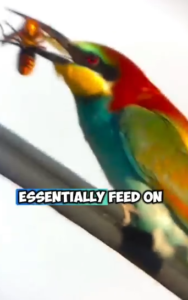Fascinating Bee-Eaters: Birds That Feast on Bees and Wasps
Bee-eaters are among the most colorful and captivating birds in the avian world, known not just for their beauty but also for their bold dietary choices. As their name suggests, bee-eaters specialize in catching and consuming bees, wasps, and other stinging insects. Belonging to the family Meropidae, these birds are found across parts of Europe, Africa, Asia, and Australia, often inhabiting open woodlands, savannas, and riverbanks.
What makes bee-eaters truly fascinating is how they handle their dangerous prey. Eating bees and wasps might sound like a risky business, but bee-eaters have developed an impressive technique to avoid getting stung. After catching an insect in mid-air with their sharp, curved beaks, bee-eaters return to a perch where they repeatedly smack the insect against a hard surface. This process stuns the insect and squeezes out its venom. The bird then rubs the insect’s abdomen against the perch to remove any remaining stinger before swallowing it whole.
Their hunting skills are remarkable. Bee-eaters often spot their prey from a perch and launch into swift, agile flights to snatch insects in mid-air. They have excellent vision and can detect fast-moving insects from quite a distance. Although their diet mainly consists of bees and wasps, they also eat butterflies, dragonflies, ants, beetles, and other flying insects.
Bee-eaters are also social birds, often seen in small flocks or larger colonies. Many species nest in burrows dug into sandy banks, cliffs, or flat ground. These tunnels can be over a meter long and end in a nesting chamber. Both parents take part in digging and later in feeding the chicks. Some species are even known to breed cooperatively, with older offspring or unrelated birds helping to raise the young.
Their vibrant plumage is another striking feature. Species like the European Bee-eater (Merops apiaster) sport vivid combinations of green, blue, yellow, and chestnut feathers. These bright colors help with mating displays and species recognition, especially in mixed flocks where several bee-eater species may gather.
Despite their beauty and ecological importance, bee-eaters sometimes face conflict with beekeepers, who fear the birds threaten honeybee populations. However, studies have shown that bee-eaters do not typically have a significant impact on local bee numbers. In fact, their presence in ecosystems can help control pest insect populations and maintain balance.
In summary, bee-eaters are stunning, intelligent, and skilled hunters. Their ability to handle venomous prey with precision is a testament to nature’s ingenuity. Whether admired for their dazzling appearance, their social behavior, or their unique hunting techniques, bee-eaters remain one of the most fascinating examples of how diverse and specialized bird life can be. 
